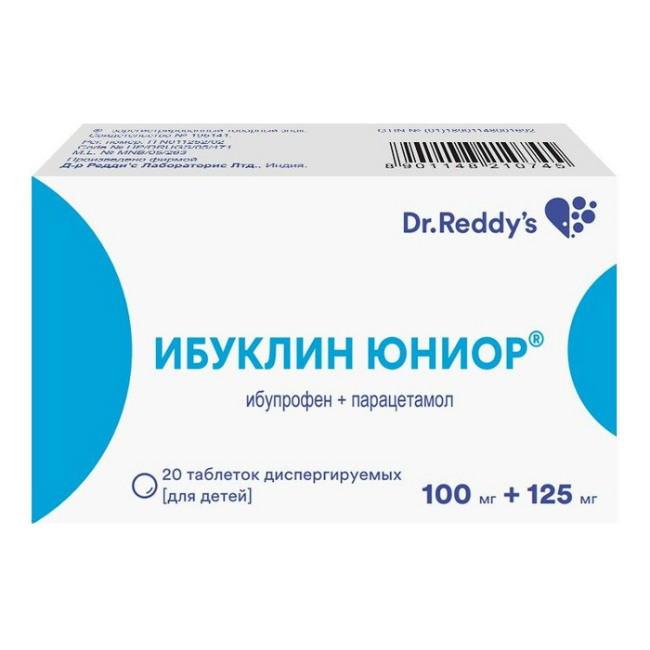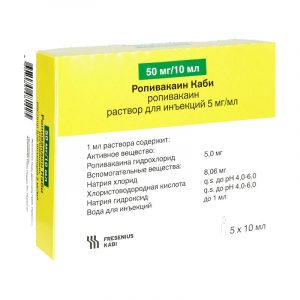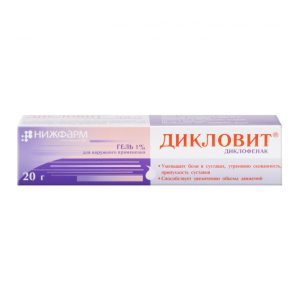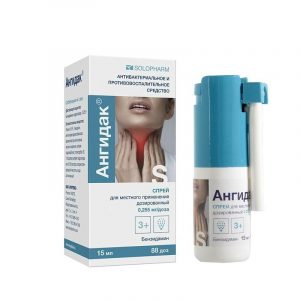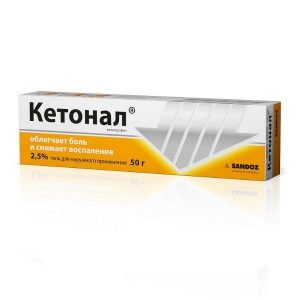Description
Release form
Dispersible tablets (for children).
Packing
20 pcs.
Pharmacological action
Pharmacodynamics
Combined drug, the effect of which is due to its constituent components.
Ibuprofen is a non-steroidal anti-inflammatory drug (NSAID), has an analgesic, anti-inflammatory, antipyretic effect.
Inhibiting cyclooxygenase (COX) 1 and 2, disrupts the metabolism of arachidonic acid, reduces the number of prostaglandins (pain mediators, inflammation and hyperthermic reaction) both in the focus of inflammation and in healthy tissues, suppresses the exudative and proliferative phases of inflammation.
Paracetamol indiscriminately blocks COX, mainly in the central nervous system, weakly affects the water-salt metabolism and the mucous membrane of the gastrointestinal tract (GIT). It has an analgesic and antipyretic effect.
In inflamed tissues, peroxidases neutralize the effect of paracetamol on COX 1 and 2, which explains the low anti-inflammatory effect.
The effectiveness of the combination is higher than the individual components.
Pharmacokinetics of
ibuprofen.
Absorption – high, rapidly and almost completely absorbed from the gastrointestinal tract (GIT).
The time to reach maximum
concentration (TCmax) after oral administration is about 1-2 hours.
Communication with plasma proteins – more than 90%. The half-life (T1 / 2) is about 2 hours.
Slowly penetrates the joint cavity, accumulates in the synovial fluid, creating higher concentrations in it than in blood plasma.
After absorption, about 60% of the pharmacologically inactive R-form slowly transforms into the active S-form.
Metabolized.
More than 90% is excreted by the kidneys (unchanged no more than 1%) and, to a lesser extent, with bile in the form of metabolites and their conjugates.
Paracetamol.
Absorption is high, binding to plasma proteins is less than 10% and increases slightly with an overdose.
Sulfate and glucuronide metabolites do not bind to plasma proteins even in relatively high concentrations.
Cmax – 5-20 μg / ml, TCmax – 0.5-2 hours.
Distributed fairly evenly in body fluids.
Penetrates the blood-brain barrier.
About 90-95% of paracetamol is metabolized in the liver to form inactive conjugates with glucuronic acid (60%), taurine (35%) and cysteine (3%), as well as a small amount of hydroxylated and deacetylated metabolites.
A small portion of the drug is hydroxylated with microsomal enzymes to form highly active N-acetyl-n-benzoquinoneimine, which binds to the sulfhydryl groups of glutathione.
With the depletion of glutathione in the liver (with an overdose), the hepatocyte enzyme systems may become blocked, leading to the development of their necrosis.
T1 / 2 – 2-3 hours. It is excreted by the kidneys, mainly in the form of glucuronide and sulfate conjugates (less than 5% – unchanged).
Less than 1% of the accepted dose of paracetamol passes into breast milk.
In children, the ability to form conjugates with glucuronic acid is lower than in adults.
Indications
Fever.
Pain syndrome of mild or moderate intensity of various etiologies: toothache, pain with sprain, dislocation, fractures.
As an adjuvant for the treatment of pain and fever with sinusitis, tonsillitis,
acute infectious and inflammatory diseases of the upper respiratory tract (pharyngitis, tracheitis, laryngitis).
Contraindications
Increased individual sensitivity to drug components (including other NSAIDs),
peptic ulcer of the stomach and duodenum
in the exacerbation phase, complete or incomplete combination of bronchial asthma, recurrent nasal acetyl polyposis and ocular paralysis other NSAIDs (including history), severe renal failure (CC less than 30 ml / min),
lesions of the optic nerve, genetic absence of glucose-6-phosphate dehydrogenase, blood system diseases period after coronary artery bypass grafting
, progressive kidney disease, severe liver failure or active liver disease,
confirmed hyperkalemia, active gastrointestinal bleeding, inflammatory bowel disease,
childhood (up to 3 years).
Use during pregnancy and lactation
If you need to use Ibuklin during pregnancy and lactation (breastfeeding),
should carefully weigh the expected benefits of therapy for the mother and the potential risk to the fetus or baby.
If necessary, in the first trimester of pregnancy should be excluded long-term use of the drug Ibuklin.I am usually not required.
In experimental studies, the embryotoxic, teratogenic and mutagenic effects of the components of the drug Ibuklin Junior have not been established.
Special instructions
The feasibility of using the drug as an antipyretic is decided in each case,
depending on the severity, nature and tolerability of the febrile syndrome.
Ibuprofen may mask objective signs of infectious diseases,
therefore, treatment with ibuprofen in patients with infectious diseases should be prescribed with caution.
To reduce the risk of adverse events from the gastrointestinal tract, the minimum effective dose should be used with the lowest possible short course.
With the simultaneous use of anticoagulants of indirect action, it is necessary to monitor the parameters of the blood coagulation system.
Avoid co-administration of Ibuklin Junior ® with other NSAIDs.
With prolonged (more than 5 days) administration of the drug, control of peripheral blood and the functional state of the liver is necessary.
The drug can distort the results of laboratory tests for the quantitative determination of glucose, uric acid in blood serum, 17-ketosteroids (drug withdrawal is necessary 48 hours before the study).
Composition
Each dispersible tablet [for children] contains:
active ingredients:
ibuprofen 100 mg,
paracetamol 125 mg
excipients:
microcrystalline cellulose 20 mg,
corn starch 59.04 mg,
lactose 5 mg,
carboxymethyl starch sodium (type A) 30 mg,
dye 4 punch (s) mg,
glycerol 2 mg,
silicon dioxide colloidal 5 mg,
flavor orange DC 100 PH * 1.6 mg,
flavor pineapple DC 106 PH ** 2.5 mg,
peppermint leaf oil 0.66 mg,
aspartame 10 mg,
magnesium stearate 1 mg,
talc 3 mg.
* Composition of flavoring orange DC 100 PH: gum arabic 81-86% aromatic additive 13-18% butylhydroxyanisole less than 0.01%.
** Pineapple flavoring composition DC 106 PH: lactose 52-57% gum arabic
31-36% aromatic additive, identical to natural 4-9% propylene glycol less than 2% aromatic additive artificial less than 2%
aromatic additive natural less than 2% aromatic additive less than 0.1%.
Dosage and administration of
The drug is taken orally
Before use, the Ibuklin Junior ® tablet should be dissolved in 5 ml (1 teaspoon) of water.
The daily dose is taken in 2-3 doses. The minimum time interval between taking the drug is 4 hours.
Children over 3 years old.
Single dose – 1 tablet. The daily dose depends on the age and weight of the child: 3-6 years (13-20 kg) 3 tablets per day
6-12 years (20-40 kg) up to 6 tablets per day.
In case of impaired renal or hepatic function, the interval between doses should be at least 8 hours.
The drug should not be taken for more than 5 days as an anesthetic and more than 3 days as an antipyretic without medical supervision.
Side effects of
In therapeutic doses, the drug is usually well tolerated.
From the digestive system: rarely dyspeptic symptoms, with prolonged use in high doses hepatotoxic effect.
From the hemopoietic system: rarely thrombocytopenia, leukopenia, pancytopenia, neutropenia, agranulocytosis.
Allergic reactions: rarely skin rash, itching, urticaria.
If side effects occur, you should stop taking the drug and consult a doctor.
Drug interaction
With the simultaneous use of the drug Ibuklin with drugs, various interaction effects may develop.
Prolonged combined use with paracetamol increases the risk of nephrotoxic effects.
Combination with ethanol, glucocorticosteroids, corticotropin increases the risk of erosive and ulcerative lesions of the gastrointestinal tract.
Ibuprofen enhances the effects of direct (heparin) and indirect (coumarin and indandion derivatives) anticoagulants, thrombolytic agents (alteplase, anistreplase, streptokinase, urokinase), antiplatelet agents, colchicine – the risk of hemorrhagic complications increases.
Enhances the hypoglycemic effect of insulin and oral hypoglycemic drugs.
Reduces the effects of antihypertensive drugs and diuretics (by inhibiting the synthesis of renal prostaglandins).
Increases the blood concentration of digoxin, lithium and methotrexate.
Caffeine enhances the analgesic effect of ibuprofen.
Cyclosporine and gold preparations increase nephrotoxicity.
Cefamandol, cefoperazone, cefotetan, valproic acid, plicamycin increase the incidence of hypoprothrombinemia.
Antacids and colestyramine decrease the absorption of the drug.
Myelotoxic drugs contribute to the hematotoxicity of the drug.
Overdose
Symptoms:
gastrointestinal disorders (abdominal pain, diarrhea, nausea, vomiting, anorexia, epigastric pain), increased prothrombin time, bleeding after 12-48 hours, sleep, tinnitus, impaired consciousness, cardiac arrhythmias, decreased blood pressure, manifestations of hepatotoxicity and nephrotoxicity, seizures, development of hepatonecrosis is possible.
Treatment:
gastric lavage for the first 4 hours alkaline drink, forced diuresis activated charcoal inside, introduction of donors of SH-groups and precursors of synthesis of glutathione – methionine in 8-9 h after an overdose and N-acetylcysteine inside or intravenously – in 12 h., antacid preparations hemodialysis symptomatic therapy.
The need for additional therapeutic measures (further administration of methionine, intravenous administration of N-acetylcysteine) is determined by the concentration of paracetamol in the blood, as well as by the time elapsed after its administration.
Storage Conditions
In a dry, light-proof and inaccessible place for children,
at a temperature not exceeding 25 ° C.
Shelf life
5 years.
Deystvuyushtee substance
Ibuprofen, paracetamol
Terms and conditions
without prescription
dosage form
resorption tablets
Dr. Reddy c, India
